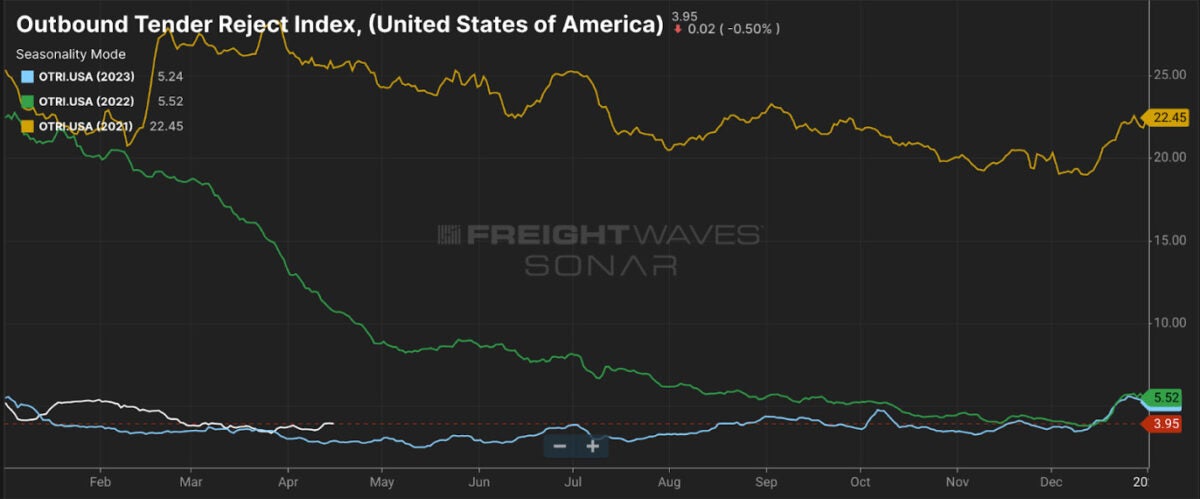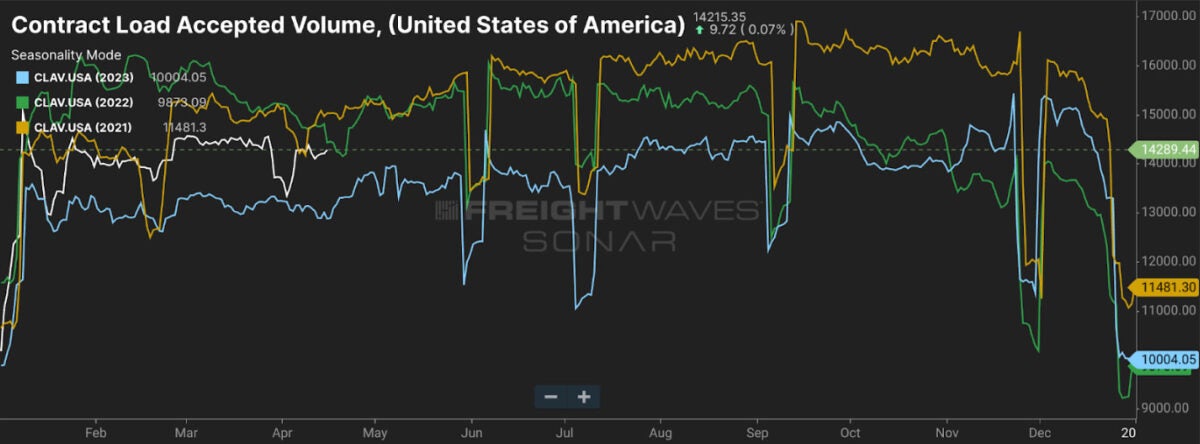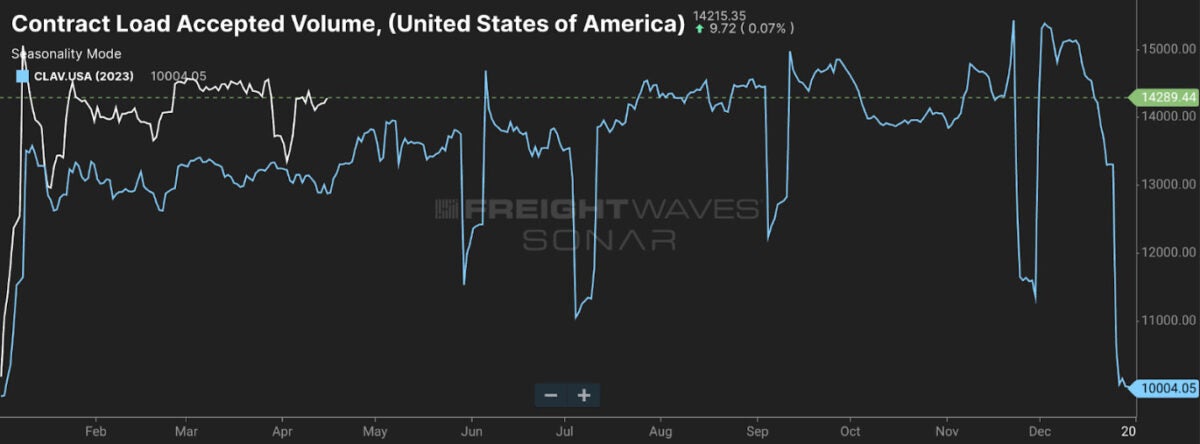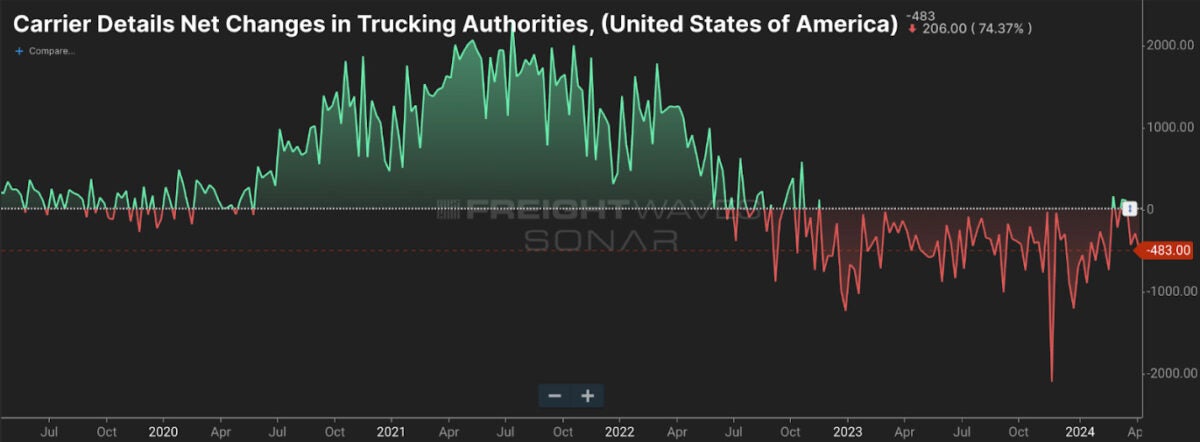On March 31, 2022, FreightWaves declared that a freight recession was imminent. More than two years later, the freight market remains in one of its deepest and longest recessions in history.
Our original conclusion was derived from signals from FreightWaves SONAR. Its high-frequency datasets, which track freight supply and demand in real-time, indicated an imminent collapse. When FreightWaves first published the article, many were not only skeptical of the conclusion, they derided FreightWaves for the call. Even after the recession took hold, few would have guessed that the freight downturn would be as deep or as long as it has been.
As we enter the third year of the Great Freight Recession, the trucking industry asks, “How much longer is the market going to remain in a recession?”
We believe that we are now at the bottom of the market.
SONAR’s Outbound Tender Rejection Index, or OTRI, measures the percentage of truckload transactions rejected by carriers. OTRI indicates that conditions are better than they were a year ago, albeit not by much.
Tender rejections are a highly reliable indicator of the balance of supply and demand. The higher the rejection rate, the more load options a carrier has. The lower the rate, the fewer load options a carrier has. While some will look at the absolute value of tender rejections, we also look at them in the context of where they have been.
Tender rejections are currently at 3.95%, up from the 2024 low of 3.39 on March 26 and up substantially from 2.88% a year ago.

We believe that tender rejections bottomed out in late March and have steadily increased throughout April, which is historically a soft month in freight. This indicates that the 2024 low is in the rearview mirror.
Contracted load accepted volumes, another SONAR index measuring contracted load demand, tell us that the market has grown since January 2023.
As of April 15, 2024, year-over-year contracted volumes are up 9%.
Contract accepted volumes are currently down 6% compared to April 2021, the peak of the COVID bull run.

While a gap certainly exists between peak volumes and current volumes, the gap is narrowing. In the past year, contracted load accepted volumes have increased by 9%.

The Atlanta Federal Reserve now forecasts that year-over-year GDP growth is up by 3%. In a normal growing economy, freight demand grows faster than economic growth. If the economy grows above 2% for the year, we expect that contracted load accepted volumes in 2025 will surpass the 2021 peaks.
Capacity will continue to decline
The growth in contracted load accepted volumes will occur at the same time that capacity continues to bleed out of the market.
Another of the many indices in the SONAR platform is the Carrier Details Net Revocation Data, which shows the increase or decline in the number of trucking companies in the market. In the chart below, anything above zero (green) shows an expansion in the number of trucking authorities, while anything below zero (red) shows a decline.

The index has been in negative territory since the fourth quarter of 2022. Capacity continues to leave the market, allowing the market to return to balance.
During the two years of the freight market’s COVID bull run, fleets built up substantial operating surpluses and were able to build strong balance sheets. This has enabled them to hang on for a long time.
For much of the Great Freight Recession, trucking fleets have been running many of their miles at losses. This has forced them to tap into the financial reserves they built up during the COVID bull run.
The Great Freight Recession has gone on longer than the COVID bull run, meaning that since the first days of the COVID lockdowns, truckers have operated primarily in recessionary territory. For those who remain in the market, their reserves are likely exhausted, as is their stamina.
However, for those who can continue, the tough times may be ending. The data suggests that a recovery in the balance of supply and demand will come as soon as fall 2024, but almost certainly by spring 2025.












Andre Winters
Its the Great Freight Recession only after the Great Freight Gold Rush through the COVID-19 pandemic!
Honky Lips
It seems like the brokers are all reading the same play book of driving the rates so low they put o/o out of business.
I would suspect if you call a broker and tell them you request a rate for shipping they’d not be giving you a quote for anything close to what today’s spot rates are.
Obviously brokers are gouging the shippers and a** r**** the o/o.
James Bauman dba Kirplopus MC 895097
The recent $95B aid package (to foreign entanglements that Washibton, Adams, etc FOUNDERS said NOT to do) will have an effect on this trucking dynamic. More printed money = further dilution of money supply = hotter inflation = no rate cuts. The now $10.50 12 pk Pepsi cans will likely hit $12. I hate; absolutely hate that this aid passed. Weakens America, fundamentally. Weakens economy. Weakens safety. We’re funding terror. Deep State is luckily failing at preventing BRICS; though you’ll read the opposite from our CIA times etc.
Stephen Webster
In Canada this time we have 500 000 students on study / work permit from lower wage parts of the world even 1% get a truck driver permit it can and may be used to pay these drivers as little as half of a U S based cross border drivers are getting paid
I was at the truck show this week in Toronto a large number of the trucking companies and some of large receivers are fighting a system to pay a fair hourly rate and putting limits of truck drivers coming as foreign students without a plan for the employer to provide medical services if sick or injured in the United States in my opinion. This drove rates to a very low price
We need a better training program with a graduate driver permit program and training for snow look at a automatic transmission endorsement
I noticed
African’s driving on a international driver’s license they got in Dubai or United Arab Emirates or somewhere. Driving as their own trucking company picking up a load then let insurance pay for not delivering the load then put the load in shipping containers going to Canada or Mexico or Africa or India. This stuff is worth a fortune in West Central Africa let’s steal it then mail it back to West Central Africa, they say..
Ray
Would like to disagree. As an oo, actually on the road. We are not at the bottom, too many big box DC’s still only at half capacity, or stuffed with their own empty trailers. Too many freight lanes, still below atl, and still dropping. Basic commodity loads are now so cheap many companies can’t afford to run. We are still way over capacity with more losses to come through 2024.
JCN
The difference between now and the “Mess” of 2008 is the influence from the “Pirate” sector. In 2008 (which only lasted 8-10 months) the Industry did’nt have the 1-2-5 truck fleets that have 20 MC numbers that they run under and gouging, stealing, committing fraud, running illegally and with no insurance. When we rebounded in 2009, the carriers who do it right(Big or Small) benefited. As with the COVID Bull Run, in late 24′ or early 25′ when this does turn around, every Pirate carrier with all their MC’s they run under will re-emerge and be asking for even more than they did during COVID. Barrier of entry is minimal for trucking companies. Carriers that try to do it right and not get caught up in the “price game” will be falling behind again. In Indianapolis, there is a sign in front of a house that states “Get your Authority to run your own truck in 1 day”.
Wild Cherry
Duke the God, lol. We’ll never get enough drivers (and their companies) to agree and get together to shut down for a week. I’m sure you’re aware of this, being a “God” and all lol. I wish we’d, at the very least, come together and take our 34+ restart all at the same time. That would get our point across and maybe wake up shippers and receivers enough to listen. In the meantime, everyone needs to KNOW their numbers and operate accordingly.